22 Self-Guided Walking Tour Stops in Georgetown, Guyana: The Best Things to Do
Have you found yourself in Georgetown, Guyana, the capital of one of the world’s least-visited countries, trying to figure out what to do in town? As a not-so-developed tourist destination among the South American countries, finding information can be difficult, so you’ve come to the right post to plan a self-guided walking tour of Georgetown, Guyana.
Related Post: If you’re looking for natural wonders in Guyana’s rich rainforest, like Kaieteur Falls or Iwokrama, and general country knowledge, check out my complete Guyana Travel Guide.
Best Things to Do in Georgetown Guyana: Self-Guided Itinerary
This itinerary will take you through all the best things to do in Georgetown, from the architecture to fascinating museums, bustling markets, and more. Aside from soaking in Guyana’s eclectic multicultural heritage with the backdrop of British colonial architecture and literally soaking in your sweat, here are the 22 best places to check out in Georgetown, Guyana. So without further ado, let’s jump right into the tour.
Note: Any stop with an asterisk is what I think are the cooler things to do in Georgetown.
Feed the Manatees at the National Park*
Who doesn’t love some good, wholesome animal feeding? Arguably, this is one of the coolest things to do in Georgetown; at least, it counts as my favorite. A popular place for locals to exercise, the main draw to Georgetown’s National Park, situated in the northern part of the city, is feeding the manatees.
Thank goodness we didn’t buy a bag of chicken for them because they eat grass. Pull up handfuls of greenery along the sides of the pond to entice the manatees over, who will eat straight from your hand. If you’ve never seen these innocent, gentle giants before, get a kick out of it when they grasp at your fingers with their trunk-like noses. Don’t worry; it doesn’t hurt, more like a tickle.
If you leave food unattended, it may be eaten by another unexpected critter. All along the park, horses are just chilling, attempting to steal your snacks. Careful; they can get aggressive and try to kick you.

Seawall
Guyana’s Amerindian name translates to “Land of Many Waters”. In an attempt to control one of these waters, a 280 mile seawall follows along the shores to keep the Atlantic Ocean from damaging the coastlines with floods. But “The Seawall” refers to the northwest corner where the Seawall starts near the Pegasus Hotel. This area is a good place to come on weekends, especially on lively Sundays, to see where the city’s families and teens hang out and eat some street food.
If you’re looking for crystalline blue waters, Guyana is not the place. Past the Seawall is just an expanse of brown muddy water as far as the eye can see. A bit smelly too.

Umana Yana & African Liberation Monument
Umani Yana is the Wai Wai Amerindian term to describe these giant thatched roof structures used as an assembly point. Urban planners brought tribe members from Rupununi to Guyana’s capital city to construct an Umani Yana, which was first completed in 1972.
Since then, destruction from high winds and a separate fire brought down the building’s original and second rendition. The local community reconstructed the current one in 2016.
The African Liberation Monument stands on the site of Umana Yana and honors those who endured and continue to struggle for freedom from oppression.

The Red House (Cheddi Jagan Research Center)
Called the Red House due to its iconic bright red wallaba shingles, the revered Dr. Cheddi Jagan lived here as the premier of British Guiana. The building now houses his legacy and freedom-fighter philosophies within.
Note: In October 2021, Red House was still closed to COVID.
Georgetown Lighthouse*
Initially lit by oil lamps and made of wood, the Georgetown community struck down the original structure in favor of the 103-foot brick one you see today.
The lighthouse keeper accesses this tower via 138 steps shining a 1000-watt light that can be seen by passing ships 30-40 miles away. Unfortunately, the top of the lighthouse is closed to tourists right now.
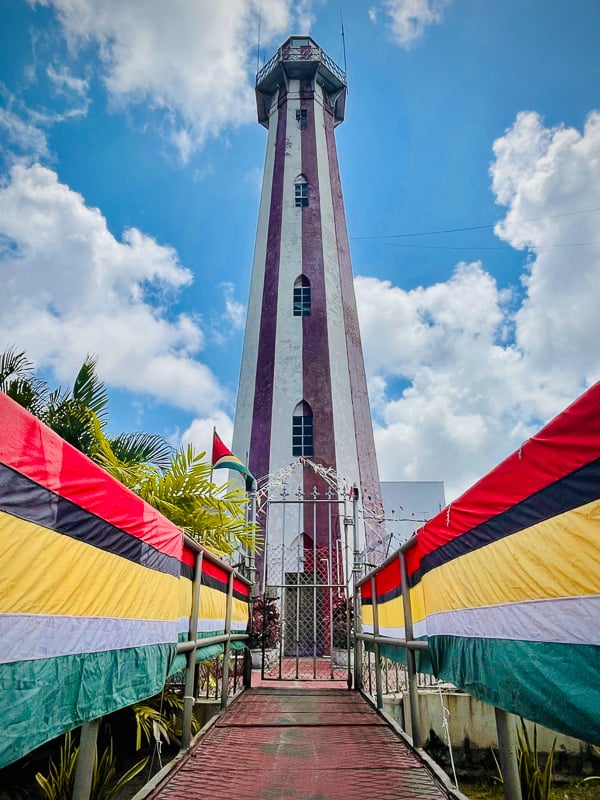
Austin House
Next on our self-guided walking tour of Georgetown is the Austin House, the former residence of Bishop William Percy Austin (1807-1892). Due to his contributions to the Anglican Church in Guyana, the house was renamed and preserved under his name.
State House (Prime Minister’s Residence)
The State House, formerly known as “Government House,” is the official residence of the President of Guyana.
Located on Main Street, it has been the home of several prime ministers since Guyana’s Independence in 1966. Ever since Dr. Cheddi Jagan’s presidency in 1992, every president has occupied the State House as their living quarters.
Walter Roth Museum of Anthropology
Housed in a Victorian mansion of 19th-century sugar planter and naturalist Sir Walter Roth, the museum contains an eclectic collection of Amerindian artifacts, colonial furniture, and natural history specimens assembled by Roth during his lifetime.
Apparently, this is the better museum to visit if you would like more knowledge on Guyanese Anthropology and Amerindian Tribe history compared to the Guyana National Museum. It’s a great way to get a taste of Guyana’s nine Amerindian tribes, with exhibits that include old photographs and artifacts.
National Museum of Guyana
The Guyana National Museum exhibits the area’s natural history, Amerindian culture, European colonization, and the post-colonial era.
Be prepared for the large amount of “preserved wildlife exhibits,” aka taxidermy and animal skeletons on display. There is even an entire area dedicated to the giant sloth, a species of mammal who stood well over 15 feet tall and lived in the region during the last Ice Age.
The National Library
Not the biggest or the most beautiful library, you can enter just to check out what the most extensive national library of the country offers or to pick up some tour guide pamphlets.
St. George’s Cathedral*
St. George’s Cathedral, a landmark that most Guyanese would refer to when asked what to see in Georgetown, holds the title of one of the world’s tallest wooden churches, standing at the height of 43.5 meters.
The present one is already the fourth rendition of St. George’s Cathedral, whereas the others have now been repurposed for other city services. The chapel’s interior is gothic in style, with intricate stained glass, big and glaringly white on the exterior, and is considered a National Monument.
During services, the church opens to the public, so check with the locals to see when you can visit.
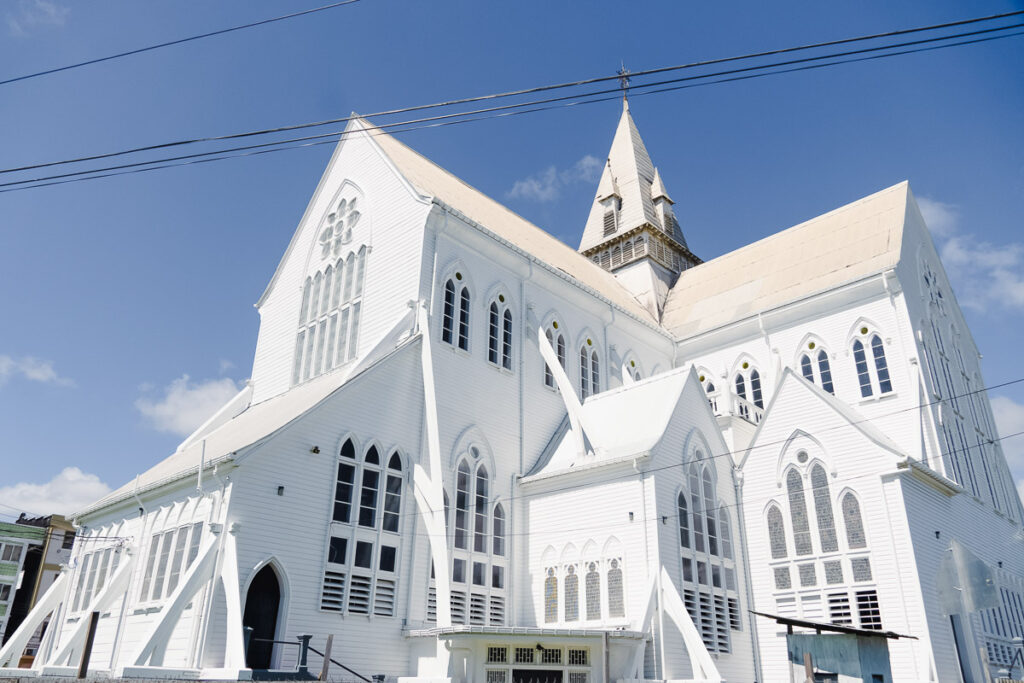
City Hall*
If there weren’t a sign that said City Hall with a lovely garden on the outside, you would never expect this to be Georgetown’s city hall. Quite run down, the abandoned appearance contrasts strongly against its well-manicured front yard. The City Hall is one of my favorite buildings in Georgetown to photograph.
In the past, I imagine the City Hall used to be quite an exquisite example of colonial architecture. Aside from acting as the seat of the city’s administration, the building during its tenure has served as a place of entertainment, a coffee parlor, a dance hall, and a concert hall.

The High Court
In honor of Queen Victoria (the statue that’s out in the front), the High Court used to be named Victoria Law Court. Aptly named, this impressive-looking building is the highest courthouse in the country.
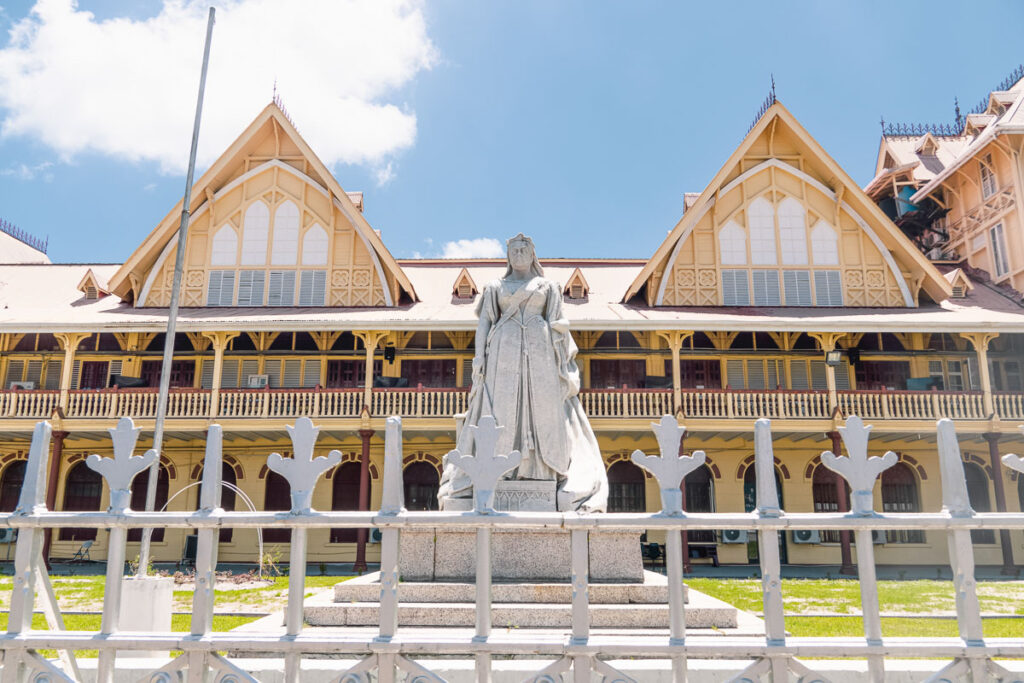
Stabroek Market*
Also referred to by locals as “The Big Market”, Stabroek Market is the city’s most popular market, encapsulating Georgetown’s spirit. Located in the central business district, this large, two-story building is busy, crowded, and full of life.
Possibly the biggest market in the Caribbeans, the distinctive clocktower serves as the main gateway to the interior.
The market is open Monday-Saturday from 7:00 to 17:00 and is a great place to buy fresh produce, car parts, clothing, and a mish-mash of everything. Several restaurants and food stands inside the market serve popular dishes.
Even if you’re not planning on buying anything, it’s worth walking around and taking in the sights and smells of this vibrant market.
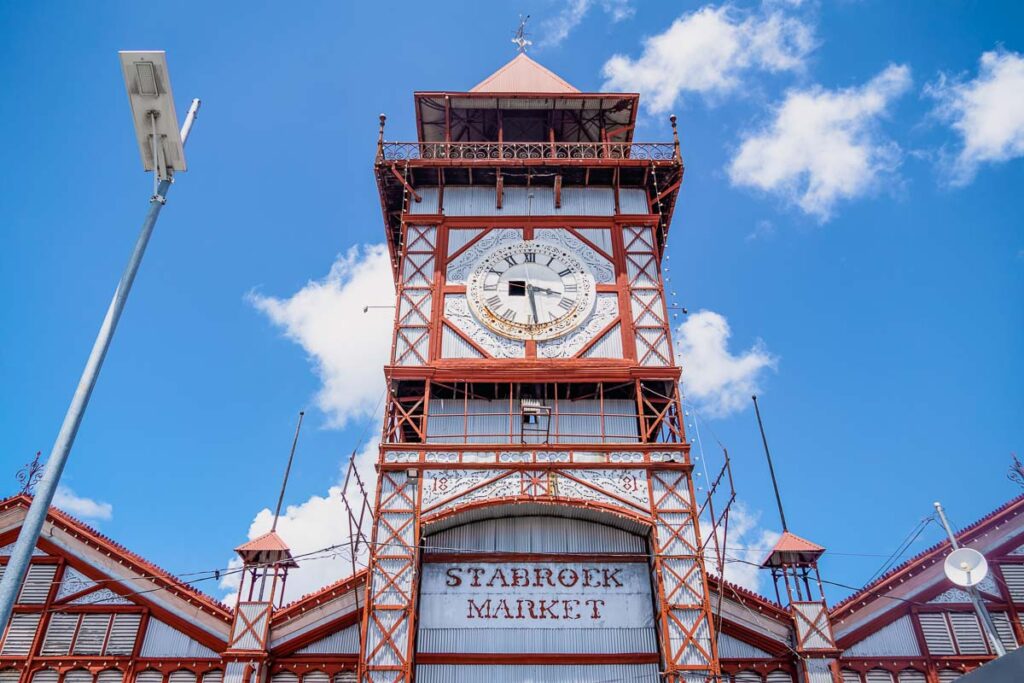
Parliament Building
The Parliament Building was built in 1834 by the prominent Joeseph Hatfield. A notable feature of the building is the intricately designed Renaissance architecture ceiling of the parliament chamber. Today, Guyana’s parliament all meet up here.
Technically, there are hours you can enter the building, but I’ve heard that “sitting hours” are unpredictable.

Andrew’s Kirk
Andrew’s Kirk is not only one of the oldest churches in the city but one of the oldest churches in Guyana.
In 1748, the site of St. Andrew’s Kirk served as a signal station for passing ships navigating the early days of Georgetown’s port before builders laid the first cornerstone in 1811.

The Cathedral of the Immaculate Conception
Georgetown’s Catholic cathedral was architected in a Romanesque style by Leonard Stokes. The church was destroyed in a devastating fire in 1913 and started its restoration two years later, this time made of concrete.

1763 Monument
Just a fountain statue, a bit odd and a bit dirty, but why not snap a picture if you’re around the block.
The 1763 Monument was erected in 1963 to commemorate the 200th anniversary of the slave revolt on Plantation Magdelenenburg in Berbice, the first revolt against the British takeover of Guyana that almost succeeded.

Castellani House
The Castellani House, once resided by Guyana’s President, Forbes Burnham, is home to the National Art Gallery and the National Art Collection.
Note: Under heavy security detail, it is closed to COVID (October 2021)
Botanical Gardens and Zoo*
Another destination that was closed when we went, I’m sure this would’ve been one of the nicer places to visit in Georgetown, Guyana.
With a vast array of tropical flowers, fruits and plants collected from all over the world, walk along the streams and paths to identify exotic ornamental, medicinal, and rare species.
A small zoo is also attached to the Botanical Gardens.

Bourda Market
Jostle through Bourda Market, a colorful place of commerce more catered to food. Try fruit drinks, fresh fruits, and vegetables you’ve never seen before. Wander through the little island near the Bourda Market, crossing most bridges to colorful storefronts. Many of these restaurants serve traditional Caribbean foods for only a couple of dollars per meal.
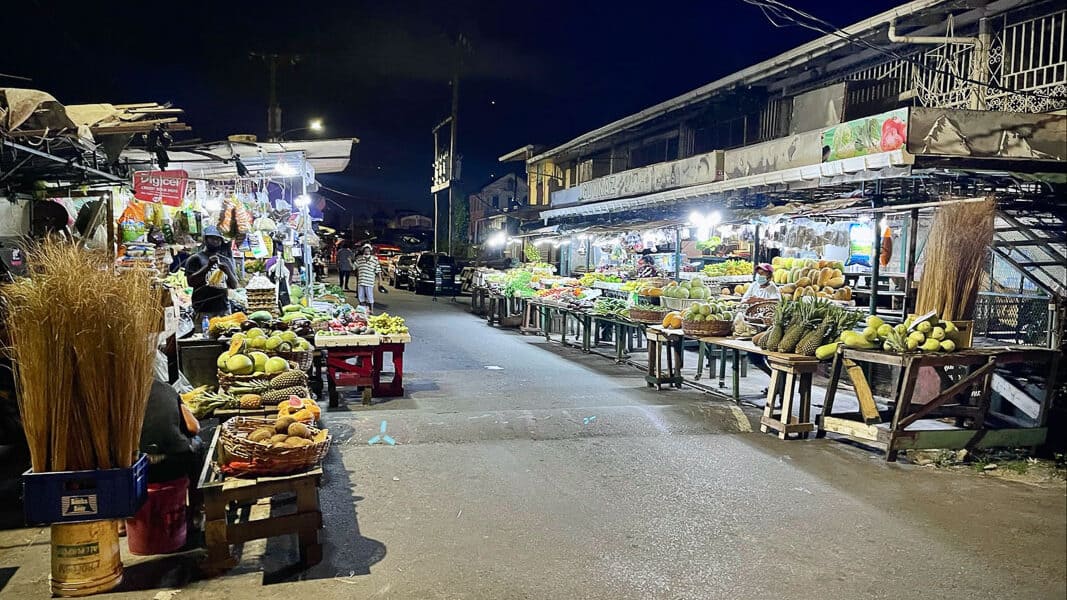
Route Map of Things to Do on a Georgetown Walking Tour

How to Get to Georgetown, Guyana
By Air Internationally
The Cheddi Jagan International Airport is 25 miles south of Georgetown and serves most of the international flights. Only a few direct flights are available internationally.
The best way to get from the airport to Georgetown is by taxi costing $25-$30. Busses service near the airport, but I’m not sure if they arrive directly at the airport.
By Ferry from Suriname
If you’re coming from Suriname by land, there’s quite a bit of logistics baked into the journey. It entails finding transportation to South Drain, crossing immigration, taking an infrequent ferry, then taking transport to Georgetown. The entire trip takes a large part of the day, starting in the early morning and arriving mid to late afternoon.
If you’re planning this journey, I’ve written out the exact steps and contacts to make the journey from Guyana to Suriname.
How to Get around Georgetown, Guyana
Taxis in Guyana
Taxis are available all over the country, both official and unofficial. Before leaving on your trip, negotiate a price with the taxi driver.
Taxi Rides within Georgetown – $200-$600 GUY ($1-$3 USD)
Taxi from Georgetown to/from the local Eugene F Correia Airport – 1000 GUY ($5USD)
Public Transportation in Georgetown and Guyana
Most busses in Georgetown depart from the transportation hub at Stabroek Market and have numbers posted above license places indicating the route they will take.
Bus lines from Georgetown, Guyana (not comprehensive):
- 32 Parika
- 40 Kitty C/ville
- 41 South/Guyhoc
- 42 Timehri
- 43 Linden
- 44 Mahaica Diagonal City Hall
- 48 Sophia
- 50 Rosignal
- 63 Moleson Creek
- 72 Mahdia
Where to Stay in Georgetown, Guyana
Georgetown and Guyana, in general, is not the cheap paradise that backpackers typically look for. The absolute most affordable room without an AC we could find was $25 USD, and upgrading to an AC room quickly turned into $45.
Julien’s Guest House
We stayed at Juilen’s Guest House most of our time in Georgetown. As my travel buddy and I are digital nomads, we found that he had the most stable Wi-Fi and a great balcony to work from. Julien’s was also right in the city center, close to all the attractions, offering home-cooked dinners for an additional fee.
We often chatted with Julien in passing, and he was very helpful in attempting to arrange the Kaieteur Falls tour for us and any other information we needed.
Armoury Villa – Hostel & Guest House
This beautiful mansion provided AC, fun and games, a full shared kitchen, and a beautiful garden for a great price.
Now the downside: as magnificent as the Armoury Villa was, it was a bit out of the way. If you’re looking for serenity, this is the best price, especially for the value. Since this hostel is situated in a nicer neighborhood, there’s no need to worry about strolling the area at night.
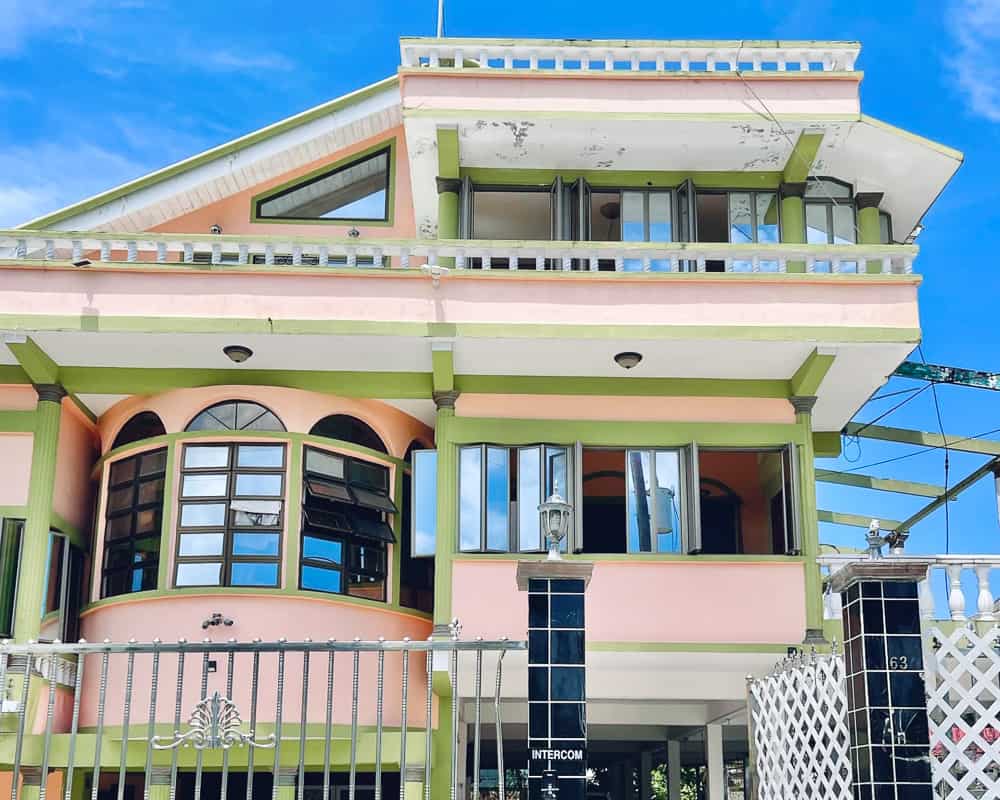
How Long Should you Stay in Georgetown, Guyana
We wouldn’t have stayed very long if we didn’t need Wi-Fi during the weekdays. If you have full days of exploration, then two days would be enough for Guyana’s capital city.
Many sites on this walking tour itinerary don’t require much time to check out, and they are all relatively close to one another. If you have time to spare, then I would say that the beauty of Guyana (like nearby Suriname) lies in its interior, which is where you should be prioritizing your time.
When Should you Visit Georgetown Guyana?
All year long, Guyana is incredibly hot and humid. If you are staying in Georgetown, you may want to consider coming closer to the rainy season, just so the sun doesn’t blaze down on you while you are touring the city.
I presume most people are planning a visit to the interior, in which case, the best time to visit is in the dry season as heavy rains make roads inaccessible.
Is Georgetown Guyana Safe to Visit
Georgetown Safety
Georgetown is known for its relatively higher crime rate than the rest of the country. Locals advised us not to show off flashy things in Georgetown, even phones and cameras. I’ve heard of a few awful experiences with crime, mainly concerning muggings.
There are no particular areas that locals told us not to enter in the city, but it’s better to exercise more caution than basic common sense. Many areas are not well-lit at night and can get a bit sketchy.
While we were there, the national police headquarters burned to the ground, destroying the entire block. Rumors abound if it was natural or corruption.
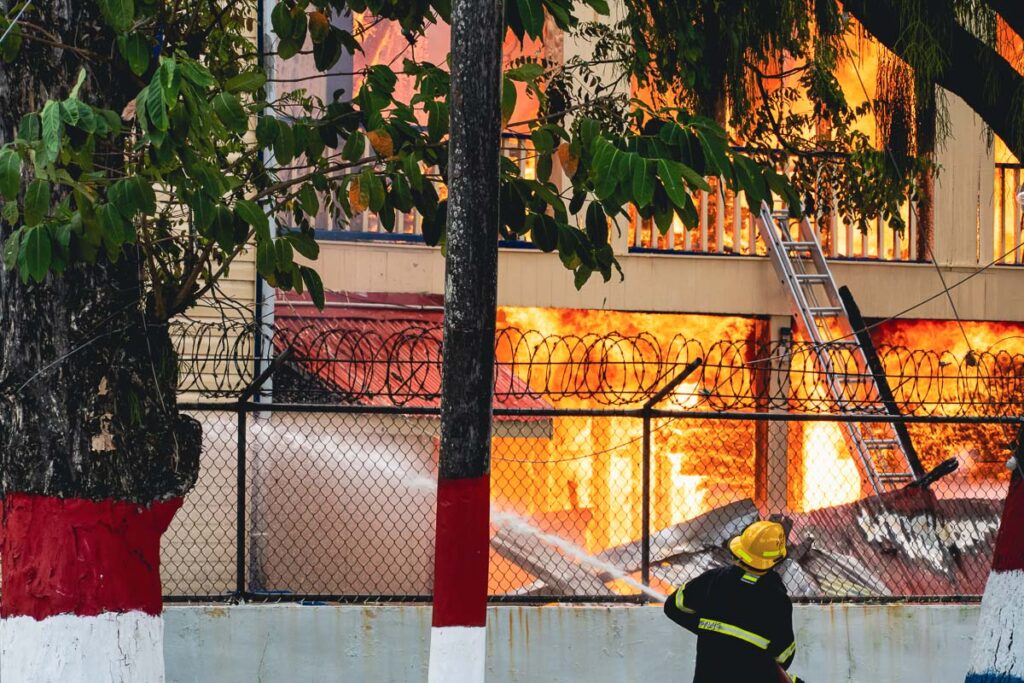
Malaria
There is a slight danger of malaria infection in the interior of Guyana, but Georgetown and the coast are free from this disease.
COVID-19
Save for entry requirements, Guyana is in the vaccination stage with pretty lax everyday rules. Information from the Vaccination Division of the Ministry of Health can be found here: +592-226-7338
Can I Drink the Water in Guyana?
For drinking water, use bottled water or authorized water source dispensaries. Showering and other household uses are fine with tap water.
Bucket List Worthy? Walking Tour Things to Do in Georgetown, Guyana
Georgetown, Guyana, is a city with a lot of character due to its melting pot of cultures. Colorful colonial buildings line the streets, and there’s a definite feeling of stepping back in time when you’re walking around Georgetown’s streets.
If you’re looking for things to do in Georgetown, Guyana, then hopefully, this self-guided walking tour will take you to all the best sights in the city. If you are short on time, these are the unmissable things I would include on my list of things to do in Georgetown, Guyana.
- Feed the Manatees in the National Park
- Shop at Stabroek Market
- Visit the City Hall
- Check out St. George’s Cathedral
- Hang with the locals by the Seawall on weekends
Catherine Xu is the founder and author of Nomadicated, an adventure travel blog that helps travelers cross off their bucket list. Since discovering traveling in 2015, she has lived and journeyed to 65 countries across 5 continents and vanlifed the west coast USA for 2+ years. These days, she splits her time in Southeast Asia and California while sharing her travel stories and resources based on first-hand experiences. Catherine's other works has been referenced in major publications like MSN, Self, and TripSavvy.

